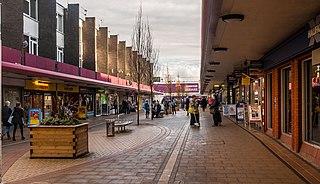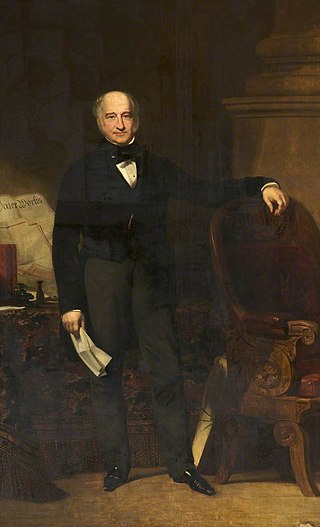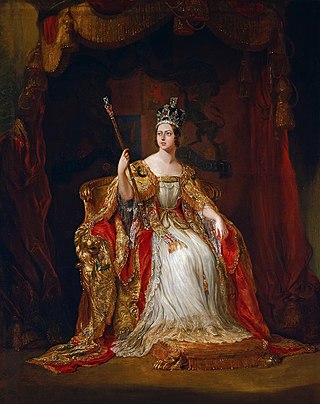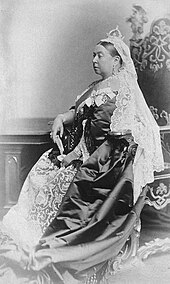
Balmoral Castle is a large estate house in Aberdeenshire, Scotland, and a residence of the British royal family. It is near the village of Crathie, 9 miles (14 km) west of Ballater and 50 miles (80 km) west of Aberdeen.

Victoria was Queen of the United Kingdom of Great Britain and Ireland from 20 June 1837 until her death in 1901. Her reign of 63 years and 216 days, which was longer than any of her predecessors, is known as the Victorian era. It was a period of industrial, political, scientific, and military change within the United Kingdom, and was marked by a great expansion of the British Empire. In 1876, the British Parliament voted to grant her the additional title of Empress of India.

Prince Albert of Saxe-Coburg and Gotha was the husband of Queen Victoria. As such, he was consort of the British monarch from their marriage on 10 February 1840 until his death in 1861.

The Great Exhibition of the Works of Industry of All Nations, also known as the Great Exhibition or the Crystal Palace Exhibition, was an international exhibition that took place in Hyde Park, London, from 1 May to 15 October 1851. It was the first in a series of World's Fairs, exhibitions of culture and industry that became popular in the 19th century. The event was organised by Henry Cole and Prince Albert, husband of Victoria, Queen of the United Kingdom.

The House of Windsor is a British royal house, and currently the reigning house of the United Kingdom and the other Commonwealth realms. The royal house's name was inspired by the historic Windsor Castle estate. Since it was founded in 1917, there have been five British monarchs of the House of Windsor: George V, Edward VIII, George VI, Elizabeth II, and Charles III.

The House of Hanover, whose members are known as Hanoverians, is a European royal house of German origin that ruled Hanover, Great Britain, Ireland, and the British Empire at various times during the 17th to 20th centuries. The house originated in 1635 as a cadet branch of the House of Welf, at that time also called by House of Brunswick-Lüneburg, growing in prestige with Hanover becoming an Electorate in 1692. A great-grandson of King James VI and I, George I, who was prince-elector of Hanover, became the first Hanoverian monarch of Great Britain and Ireland in 1714. At the end of his line, Queen Victoria's death in 1901, the throne of the United Kingdom passed to her eldest son Edward VII, a member of the House of Saxe-Coburg and Gotha, through his father Albert, Prince Consort. The last reigning members of the House of Hanover lost the Duchy of Brunswick in 1918 when Germany became a republic.

Salford is a city in Greater Manchester, England. The city is situated in a meander on the western bank of the River Irwell which forms its boundary with Manchester and its city centre. Landmarks in the city include the 100 Greengate skyscraper, the old town hall, cathedral and St Philips Church. It is the main settlement of the wider City of Salford metropolitan borough.

Worsley is a village in the City of Salford, Greater Manchester, England, which in 2014 had a population of 10,090. It lies along Worsley Brook, 6 miles (9.7 km) west of Manchester.

Swinton is a town in the City of Salford in Greater Manchester, England. southwest of the River Irwell, 4 miles (6.4 km) northwest of Manchester, adjoining the town of Pendlebury and suburb of Clifton. In 2014, it had a population of 22,931.

By the arrangements of the Canadian federation, Canada's monarchy operates in Ontario as the core of the province's Westminster-style parliamentary democracy. As such, the Crown within Ontario's jurisdiction may be referred to as the Crown in Right of Ontario, His Majesty in Right of Ontario, the King in Right of Ontario, or His Majesty the King in Right of Ontario. The Constitution Act, 1867, leaves many functions in Ontario specifically assigned to the sovereign's viceroy, the lieutenant governor of Ontario, whose direct participation in governance is limited by the constitutional conventions of constitutional monarchy.

By the arrangements of the Canadian federation, Canada's monarchy operates in Quebec as the core of the province's Westminster-style parliamentary democracy and constitution. As such, the Crown within Quebec's jurisdiction is referred to as the Crown in Right of Quebec, His Majesty in Right of Quebec, or the King in Right of Quebec. The Constitution Act, 1867, however, leaves many royal duties in the province specifically assigned to the sovereign's viceroy, the lieutenant governor of Quebec, whose direct participation in governance is limited by the conventional stipulations of constitutional monarchy.
Sir John Potter was a Liberal Party politician in the United Kingdom.
Australia is a constitutional monarchy whose Sovereign also serves as Monarch of the United Kingdom, New Zealand, Canada and eleven other former dependencies of the United Kingdom including Papua New Guinea, which was formerly a dependency of Australia. These countries operate as independent nations, and are known as Commonwealth realms. The history of the Australian monarchy has involved a shifting relationship with both the monarch and also the British government.

Peel Park is a public urban park in Salford, Greater Manchester, England, located on the flood plain of the River Irwell below Salford Crescent and adjacent to the University of Salford. It was the first of three public parks to be opened on 22 August 1846, for the people of Manchester and Salford, paid for by public subscription. The park was the main public venue for the 1851 royal visit of Queen Victoria to Manchester and Salford and has been the subject of a number of paintings by the Salford artist, L.S. Lowry.

Sir Elkanah Armitage DL was a British industrialist and Liberal politician.
The Art Treasures of Great Britain was an exhibition of fine art held in Manchester, England, from 5 May to 17 October 1857. It remains the largest art exhibition to be held in the UK, possibly in the world, with over 16,000 works on display. It attracted over 1.3 million visitors in the 142 days it was open, about four times the population of Manchester at that time, many of whom visited on organised railway excursions. Its selection and display of artworks had a formative influence on the public art collections that were then being established in the UK, such as the National Gallery, National Portrait Gallery and the Victoria and Albert Museum.

Victoria Bridge is a stone arch bridge in Greater Manchester, England. Completed in 1839 and named after Queen Victoria, it crosses the River Irwell, connecting Salford to Manchester.

The coronation of Victoria as Queen of the United Kingdom took place on Thursday, 28 June 1838, just over a year after she succeeded to the throne of the United Kingdom at the age of 18. The ceremony was held in Westminster Abbey after a public procession through the streets from Buckingham Palace, to which the Queen returned later as part of a second procession.

Worsley New Hall is a former mansion and gardens by the Bridgewater Canal in Worsley, Greater Manchester, England, 8 miles (13 km) west of Manchester. The gardens were renovated by the Royal Horticultural Society and opened as RHS Garden Bridgewater in 2021.

The following is a timeline of the history of the city of Manchester in north west England.



















